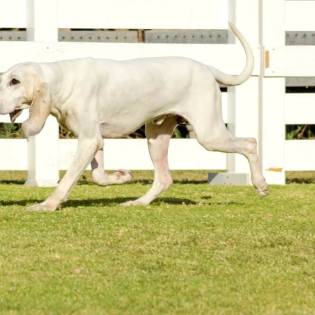Weimaraner
The Weimaraner is a large, all-purpose hunting dog known for its gray-silver coat. The dog is famous for its loyalty and strength. This dog originated in the 19th century in the city of Weimar (in modern-day Germany) and was developed for hunting purposes.
Weimaraners were used to hunt big animals, like bears and deer, but then, as hunting large game became less popular, they were used for smaller animals. These dogs were bred by noblemen of the Weimar court who wanted to create a hunting dog with a good sense of smell, endurance, intelligence, speed, and fearlessness.
FUN FACT: It’s believed that the first Weimaraner dog was bred by Karl August, the Grand Duke of Saxe-Weimar-Eisenach, who ruled in the city of Weimar from 1758 to 1815.

Height:
23-27 in (58-68 cm)

Weight:
55-88 lb (25-40 kg)

Origin:
Germany

Life Expectancy:
10-13 years
Dog Breed Characteristics
Weimaraners are a relatively young breed that is about two hundred years old. Since their beginnings, detailed records were kept, and breeding was carefully conducted. Their characteristics were especially “bred into” the breed and breed standard is in place in all major cynology associations.
Coat colors
The Weimaraner is an athletic, muscular, strong dog. Their life expectancy is 10 to 13 years. Weimaraners are large dogs with elegant lines. Their look combines grace and balance. A properly bred Weimaraner is solid colored (ranging from mouse-gray to silver-gray) but can have a small white spot on the chest.
The coat is short, sleek, smooth, and easy to maintain that way. Even when the dog is running through mud, the dirt just seems to fall off it. When it comes to grooming, they do not require any special treatment. Weekly brushing is enough, except during the shedding season (spring and autumn), when they should be brushed more frequently.

FUN FACT: This dog is often called “Grey Ghost.”
Traditionally, the tail used to be docked, but in several countries, tail docking became illegal, so you can often see a Weimaraner with an entire tail. The eyes of the dog may be light amber, grey or blue-grey.
This is an energetic dog that needs a lot of exercise. These dogs enjoy running, swimming, hunting, hiking, and fetching.
Good family dog
They are the happiest living with families who lead an active life and spend a lot of time outside. Weimaraners are devoted, love their people, and want to please them. They tend to form strong bonds with their families so keep in mind that for them, the best family is the one where there is always at least one member at home with them.
They can be alone for a little period of time. If they are left alone for a long time, they can suffer from separation anxiety which can lead to developing all sorts of behavioral issues; most commonly, they start to be destructive around the house. Also, when they want attention, especially after being left alone, this dog can show their stress by barking excessively.

Learning them to stop barking is an essential part of the training. Weimaraners are not suitable for condo or apartment living; as they are a highly active breed, they need a large yard where they can run and play.
Famous Weimaraner photographs, calendars, or books some of us might have seen are probably made by the famous photographer by the name of William Wegman. He used wigs, props, and many different props to show us the Weimaraner’s ability to assume human-like features and expressions. You might have seen his photographs of his dogs dressed as Louis the XIV or lying in bed watching television.
FUN FACT: Make sure your yard is escape-proof because these dogs are very good at learning how to open a door or a gate, jump over them or dig under them

Training
Except for a lot of physical exercises, these highly intelligent dogs need a lot of mental stimulation, too. If they are not busy, they can easily get bored and develop destructive behavior. Remember this: a Weimaraner at rest is bored, and a bored Weimaraner is destructive.
Proper exercise makes it easier to train and control. They learn quickly and need firm, experienced training. The right owner for this dog is an owner that understands how to be a pack leader and can provide leadership. Otherwise, these dogs can become stubborn, willful, and combative with other dogs. Because of really high prey drive, Weimaraners are usually not compatible with cats and other small animals.
These dogs live to chase any object that moves, including runners and bikers.
Most of these dogs are friendly, fearless, and obedient, but, on the other hand, don’t get this dog if you are not ready to work hard with your dog. They are smart, restless, and will always test the boundaries. This dog will take over the household if not trained properly.
Aggression and shyness are flaws in this breed and must be dealt with early in dogs’ life.

FUN FACT: Weimaraner puppies are born with striking pale blue eyes that fade to amber or blue-gray as they mature
Health problems
This dog is generally a healthy dog but can suffer from a few hereditary health issues, such as
- dilated cardiomyopathy (serious heart disease),
- hip dysplasia;
- bloat or gastric torsion (a life-threatening condition where the stomach twists itself, pinching off blood vessels and the routes of food traveling in or out),
- von Willebrand's Disease (an inherited blood disorder that is caused by a deficiency in clotting factor VIII antigen),
- eye problems such as Progressive Retinal Atrophy or distichiasis (a condition where too many eyelashes grow and cause irritation to the cornea and tearing),
- ectropion (eyelids roll outwards),
- entropion (eyelids folding inwards irritating or injuring the eyeball)
- skin allergies.
It's also important to check the dog's ears on a regular basis and to clean them when necessary because Weimaraners are very prone to suffering from ear issues.

FUN FACT: Because of their webbed paws, these dogs are great swimmers
FAQ
Yes, Weimaraners make excellent family dogs. They are energetic, friendly, and outgoing. They will require plenty of activities, so they will fit best into active families that enjoy jogging, hiking, or biking.
Weimaraners are usually not excessive barkers. They are quiet, confident dogs that will not bother your neighbors too much. They can become excessive barkers if they are left alone or if they get bored.
Weimaraners are usually not aggressive. They have the potential to develop aggressive behavior because they are territorial and distrustful towards strangers.
The Weimaraner puppy’s average price is around $700, but top-quality breeding lines go from $1.500 - $2.500. Top show lines can go for more than $7.500.
Yes, Weimaraners are fairly cuddly with their families. They love giving standing hugs and sleeping with their owners in bed.
Weimaraners are not a breed that should be left alone for too long. They are prone to separation anxiety and will hate to be left alone at home.
Weimaraners are medium shedders. They have a short, glossy coat, and owners often think these dogs won’t shed much. Their short hair can be difficult to vacuum and clean.
There are some subtle differences between male and female Weimaraners. Males are more intense, but in general, picking a male or female dog is entirely up to the owner’s preference.
Weimaraners are a breed that was created to work and live closely with their humans. They were meant to be a part of the family since their beginnings, and that is why these dogs are clingy. They are also prone to separation anxiety, which is another thing that impacts clinginess.
Weimaraners have one of the strongest protective instincts out of all sporting breeds. Mind you, it is still a sporting breed and not a guardian. However, they might react protectively if there is an immediate danger to their family.
Weimaraners are very active, and they will require at least two hours of activities per day. They will need long walks and intense workout sessions every day. They are a sporting breed that needs plenty of exercises.
Weimaraners are not considered a hypoallergenic breed. They shed quite a lot, and that means there are plenty of allergens left around the room.

Weimaraner breeders
When buying a Weimaraner, make sure to buy it from a responsible Weimaraner breeder who will provide you with all the information you need to know and will show you health clearances for both of the puppies parents. Also, keep in mind that unethical breeders may advertise blue or black dogs as very rare to attract buyers and earn money, but blue and black Weimaraners are not acceptable in the breed standards and can’t compete in the show ring.
If you are looking to buy this dog, prepare yourself to spend some serious money. Weimaraner puppies from reputable breeders are very expensive; they usually cost between $1,500 and $2,000 per puppy. When you add food and veterinary costs, you will see that it is not cheap to be a proud owner of a beautiful Weimaraner.
World Dog Finder team

Updated at31.08.2023.
Breed History
First Weimaraners came to life, as we already mentioned, in the 19th century in the Weimar State. The Weimar noblemen tried to create a perfect hunting dog that had specific qualities they were looking for in a breed. They wanted their dogs to be fast, have great noses so they would excel in tracking duties, have great endurance so they could track and hunt for great periods of time, and to keep the pointing abilities of their ancestors.
They were originally bred for big game hunting, such as deer, bears, and boars, but through time, they showed a lot more success in fowl hunting. Weimaraner breeding clubs and historians say that the Grand Duke of Sachsen- Weimar by the name of Karl August, is single-handedly responsible for the creation of the breed, but there are no official records that confirm this theory.
Whether the Weimaraner grey-silver coat was created on purpose is still a mystery and open for speculation. Some say that it happened by accident, and some say that it is inherited by the now-extinct German dog Huehnerhund and the blue-grey Great Dane.

At the beginning of the existence of this breed, the Weimar noblemen severely controlled the ownership and utility of this new dog breed. They have formed the German Weimaraner Club and have restricted membership. The “members-only” policy was put in place, and the ownership and breeding of the Weimaraners were allowed for their members.
That way, they were trying to ensure that the qualities and traits of this dog remained with every generation, and they were afraid that if they allowed the general public to breed these dogs, they would significantly drop the breeding and general dog quality. The Club was very secretive, and they allowed only a handful of non-members to know more about this new breed.
Whether they did this on purpose is not known, but it helped to mistify these dogs, and soon, many legends and myths came to life about the great silver hunting dog. What they managed to do is refine the Weimaraner’s temperament and hunting abilities with selective breeding and successfully switched them from big game to small game hunters.

The introduction of this breed to the United States of America and the popularization of this breed can be credited to Howard Knight, a New England sportsman. In 1928 he applied to the German Weimaraner Club. He promised and gave every possible insurance that he would uphold the breed quality, but still, the Club was reluctant to give Mr. Knight a chance.
They sent him two sterilized dogs. He was interested primarily in breeding Weimaraners and continued to apply for new dogs that would be able to produce litters. His efforts finally worked, and in 1938 the German Weimaraner Club sent him three females and a young male. Americans fell in love with these dogs immediately, and a few years later, in 1942, some breed lovers and enthusiasts formed the American Weimaraner Club.
They immediately put a breed standard in place and applied for full registration with the American Kennel Club. At the beginning of 1943, AKC registered Weimaraners on a definite basis, and the following year these dogs were exhibited in the Westminster dog show.
The great rise of Weimaraner kennels and dog owners happened in the 1940s after the Second World War started. It was getting increasingly hard to keep good dogs in Europe, and many best-quality Weimaraners were sent to the United States.

These days these dogs are again growing in popularity. They are the 41st most popular dog breed in the USA. These dogs certainly have a special, mystical appeal to them, but there is also a downside to their popularity. Some people that are interested in these dogs do not think things through and realize that these are hunting dogs at their core.
They have a lot of energy and need owners that know how to handle them. There are some problems with that, and a lot of these dogs end up in shelters. If you are interested in these dogs, check your local shelters, and maybe you will find a loving Weimaraner in need of a new home.

















Share